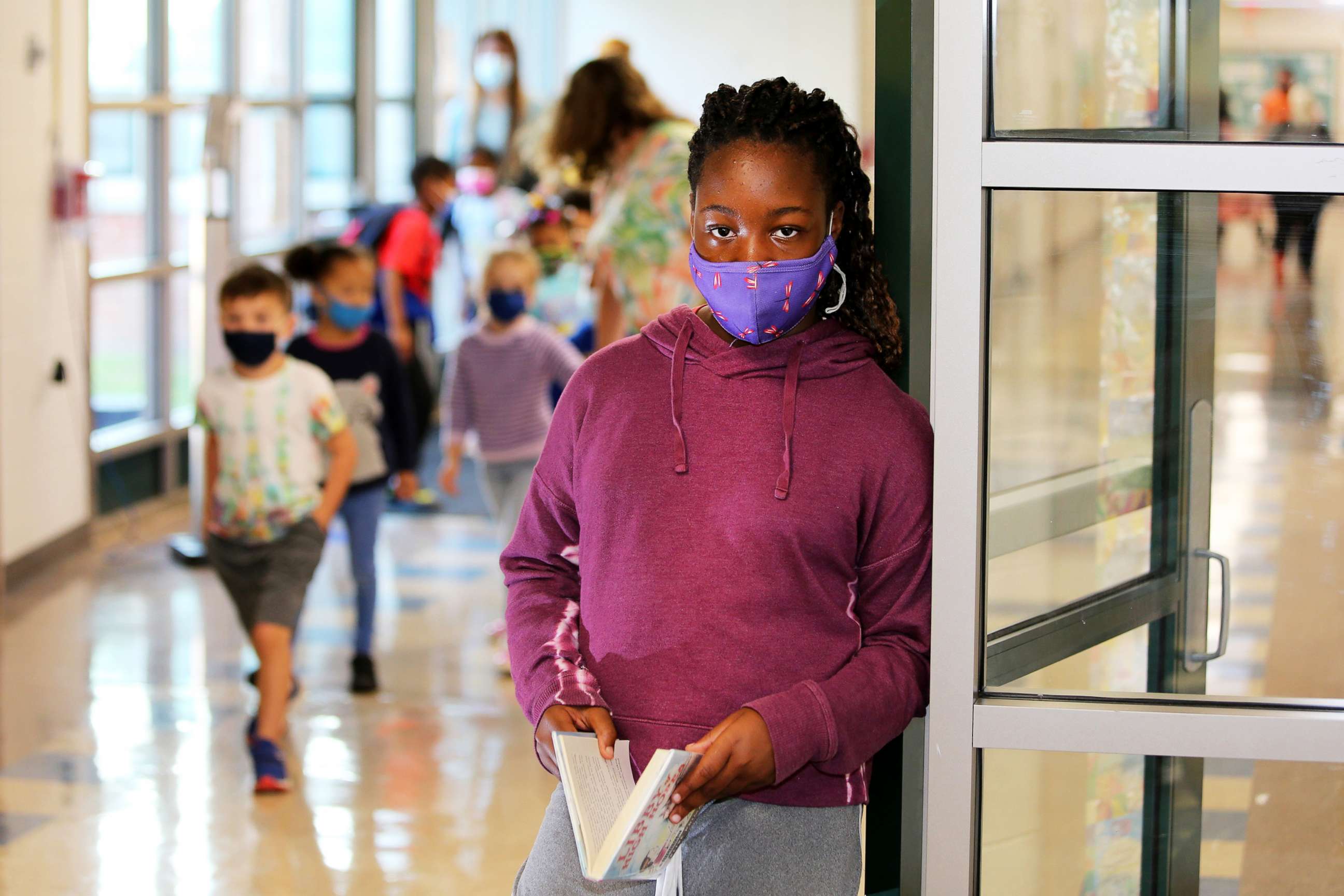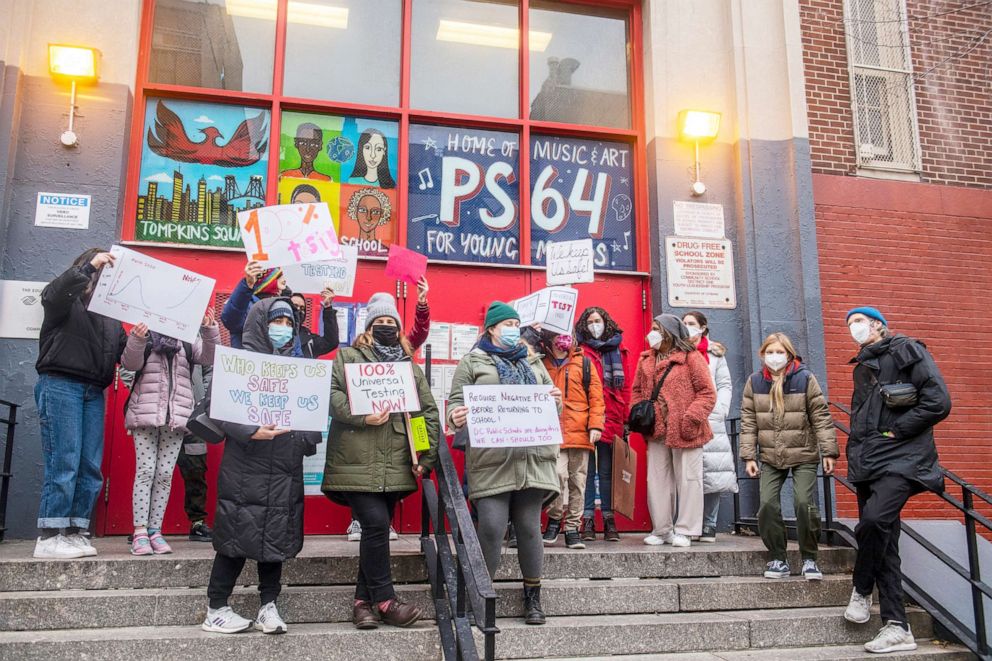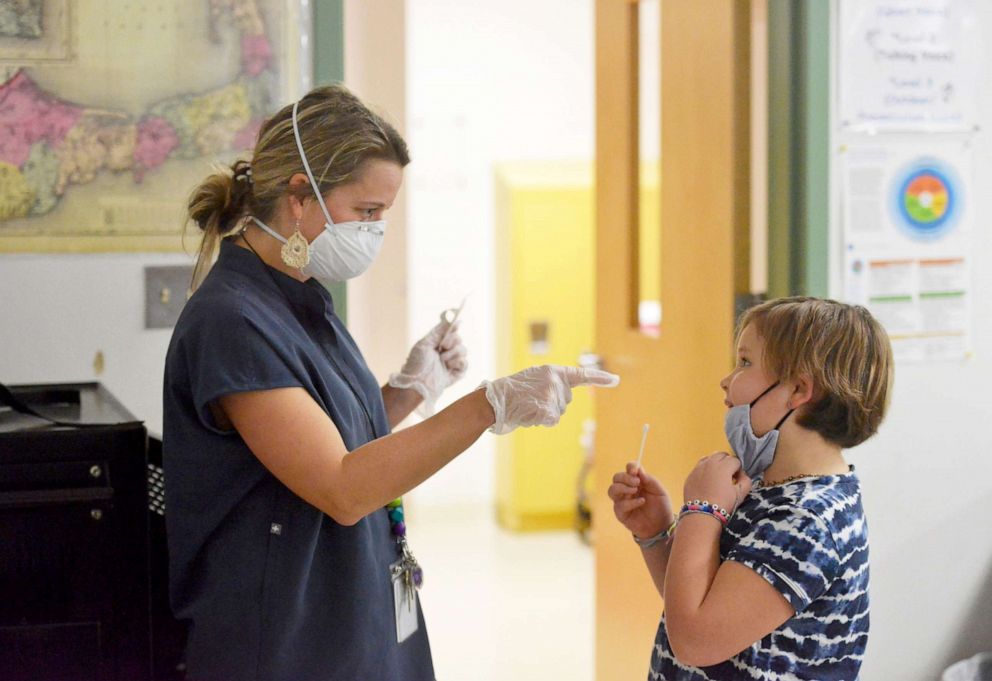Omicron surge putting strain on schools to stay open, experts say
Some are focusing on testing and vaccination amid the latest surge.
COVID-19 has been a major challenge for schools.
From shutting down in March 2020, to reopening and trying to stay open, the task has been varied and in some cases monumental.
This school year -- the third since the pandemic began -- has presented its own promise and challenges, from vaccines being available to millions of students, to new "test-to-stay" protocols and more transmissible variants. Still, many schools were able to stay open safely with multiple protections in place.
For Elizabeth Stuart, a professor in mental health and health policy and management at the Johns Hopkins Bloomberg School of Public Health, a multipronged mitigation strategy has been key to keeping schools safe.
"I think it has been heartening this fall that, in general, schools have been open," she told ABC News. "Those that had good sets of protections in place, including masks, teacher vaccinations, some sort of symptoms screening, good ventilation, have been able to open successfully with sometimes without very many disruptions."
But as the omicron variant COVID-19 surges nationwide, schools are reflecting the high rates of community transmission -- forcing officials to reassess their protocols and double down on efforts to keep classrooms open in the new year.
"Community transmission rates are just so high right now, that then the school starts to feel it as well," she said. "That doesn't mean the schools are contributing to the spread. But when there's so much virus in the community, of course, the schools are going to be starting to feel that as well."

Exactly how much COVID-19 transmission there has been in schools is unclear, but studies based on contact tracing suggest that the community transmission plays a larger role in case levels among students, especially where safety protocols are followed.
There are some areas of concern going forward, including winter sports and the unprecedented surge from the omicron variant, but experts are hopeful that the many tools officials have at their disposal can help mitigate the impact of the virus and continue in-person learning.
Recent spikes in cases
Public data on school COVID-19 cases varies, and there is no national data for this school year. However, several Northeast states with comprehensive dashboards are showing sharp increases in recent weeks, as the region leads the nation in new coronavirus cases per capita.
In New Jersey, for instance, which tracks COVID-19 data from over 60% of K-12 public schools, case rates among students and staff started spiking in early November, reaching their highest levels so far this school year. According to the latest data, more than 44,500 student cases have been reported so far this school year, including over 7,700 the week of Dec. 19 alone.
Connecticut has seen a similar growth; for the week ending Dec. 22, the state reported over 3,000 student cases, compared to under 500 the week ending Nov. 3. About two-thirds of the new cases were in students who were not fully vaccinated, the data shows.
Though not as widespread as last school year, closures have also risen in recent weeks. More than 1,000 schools or districts are virtual or closed this week due to rising COVID-19 cases in students and staff and logistical challenges, according to Burbio, a company that monitors COVID-19 policies in over 80,000 K-12 schools. That number is lower than widespread closures in November during the delta surge, though higher than what was tracked in late August, when that surge began. Recent closures are largely concentrated in the Northeast and Upper Midwest, according to its tracker.
Omicron, which has now been detected in all 50 states and has quickly become the dominant variant of new cases here, brings another level of concern. Growing research indicates it spreads more easily than any other variant identified during the pandemic, though it's too soon to tell if it causes more mild or severe illness.
"[There's] high level of concern from schools across the country right now," Dr. Sara Bode, a member of the American Academy of Pediatrics Council on School Health and an author of the AAP's interim guidance on schools amid the pandemic, told ABC News. "The concern is, as all these students are now back home with their families and in their communities with these high rates of COVID, what's that gonna mean for the return?"
School vs. community transmission
Outbreaks can and do occur in schools, though multiple studies have shown that transmission in school settings is typically lower than or the same as that of the community when several mitigation measures are in place, such as mask-wearing, testing, ventilation and physical distancing, according to the Centers for Disease Control and Prevention.
"We know that school is not necessarily the driver of COVID transmission, it's a reflection of the community rates of COVID," Bode said. "School is probably one of the safest places kids can be."
But, she continued, "at some point, do we get to such a high rate that it just makes it really challenging to be able to have in-person learning?"
That's the question some schools are facing now.
New York City, home to the country's largest public school system, has seen a rapid increase in school cases in recent days, forcing more than 400 out of approximately 48,000 classrooms districtwide to close, according to the latest city data. At least 11 of some 1,600 schools were also closed as of Thursday night; since the school year started, 17 schools total have temporarily closed.
As the number of new COVID-19 cases reported citywide has reached record levels in recent days, city leaders have said they are intent on keeping classrooms open, and that measures including masking, surveillance testing and mandated staff vaccinations have kept COVID-19 rates low.
The New York City school seven-day average COVID-19 testing positivity rate is also just over 2%, according to city data. The school rate has been "higher than what we've seen in previous weeks, but it remains relatively low," Dr. Dave Chokshi, commissioner of the city's health department, said during a press briefing earlier this week. Citywide, the seven-day average positivity rate is over 11%.

New York City public schools are supposed to randomly test 10% of their unvaccinated student population weekly, per city Department of Education protocols. Some city officials and the teacher's union have charged that protocol isn't widespread enough to provide a clear picture of COVID-19 transmission -- a notion Mayor Bill de Blasio has pushed back against.
"We're testing in every school, every week, the results are extraordinarily consistent and show very low levels of COVID," he told reporters earlier this week. "You have all those health and safety measures in place, you have every adult vaccinated. This is one of the safest places in the city by definition."
Los Angeles County, which has widespread school testing, has similarly found low test positivity rates in students and staff. So far this school year, it has remained below 1%, data from the county's health department shows.
Spotlight on sports
One area that is "particularly problematic" right now in schools is sports, said Bode. "These are winter sports -- they're indoor, lots of contact." Mask usage may also vary based on local guidelines.
As the medical consultant for the Columbus, Ohio, school district, Bode has seen high school teams needing to postpone or cancel games this season, much like professional sports, due to positive cases. On some teams, as many as one-third of the team has tested positive, she said.
"That is going to be the other consideration in these winter months -- how many cases is too many?" she said. "When do we decide just to take a break from athletics for 10 days for a particular team, if it seems like there's an outbreak?"
"I think those are other considerations schools are going to be grappling with when they return," she continued.
Some districts are already doing just that. Springfield Public Schools in Springfield, Massachusetts, this week postponed all winter sports amid a rise in COVID-19 cases in the school and community and the new, highly transmissible omicron variant. School and health department officials plan to discuss restarting the season after the holiday break.
Connecticut this week halted guidance that would have allowed fully vaccinated students to compete without wearing masks, following policies already in place in neighboring Massachusetts and Rhode Island, citing the "the rapid rise in COVID-19 community case rates and the emergence of this more contagious variant."
Post-winter break
Schools are heading into winter break as pediatric cases continue to surge nationwide.
Since the first week of September, there have been nearly 2.3 million child cases -- nearly a third of the total pediatric cases reported since the onset of the pandemic -- including approximately 170,000 in the last week alone, according to a new report from the AAP and the Children's Hospital Association released on Monday. Though children tend to have mild infections, there can be acute cases; over the last month, pediatric COVID-19-related hospital admissions also have increased by 33%, according to federal data. Children could also transmit the disease to more vulnerable people.
Public health officials have pointed to a variety of factors that are fueling the latest COVID-19 surge, including more indoor gatherings during colder weather, relaxed protocols, the Thanksgiving holiday, unvaccinated populations and waning immunity against the backdrop of two highly transmissible variants -- delta and omicron.
To limit COVID-19 transmission once students return to the classroom this new year, some leaders are boosting testing. On Wednesday, California Gov. Gavin Newsom announced that the state will be distributing 6 million free rapid tests to school children -- about one or two tests per child -- "so that they can get those results back quickly and make sure when they go back in person, they're doing so safely knowing that they have not contracted the disease over the holidays," he said.
Similarly, in Washington, D.C., the district health department will be distributing 100,000 rapid tests to schools to test children returning from the winter break, city officials announced this week. D.C. public schools will cancel classes for two days to allow for families to pick up the tests, with instruction resuming on Jan. 5.

Public health experts and school leaders are also stressing vaccination amid the latest surge to help limit transmission among children, protect against severe illness and limit disruptions due to exposure. Those ages 5 and up are eligible to get the COVID-19 vaccine, though less than a third of the pediatric population -- those under 18 -- is fully vaccinated, according to federal data.
D.C. this week joined a small but growing list of cities and school districts to require COVID-19 vaccination in schools for students. Students eligible for a COVID-19 vaccine that's been fully approved by the Food and Drug Administration will have to be immunized beginning March 1, following regulations from the D.C. Council, with enforcement beginning in the 2022-2023 school year.
"This adds to the safety of our schools," D.C. Mayor Muriel Bowser said at a press briefing Wednesday. "We urge parents right now to make a plan to have their children vaccinated, even before the deadline, because the benefit is you get the extra months and weeks of protection."
Bode is optimistic that there we won't see "mass amounts" of school districts going virtual in the new year, though noted that case counts and other issues like staffing shortages may lead to targeted school closures as needed.
"'I'm hoping that we've learned some good lessons over the time of the pandemic to understand that we can do this, we just have to really double down with our mitigation strategies and be vigilant with the data, have frequent testing, have vaccination and have a plan that can be flexible in these smaller situations," she said. "I think that's the most effective."
Stuart is also confident due to the number of mitigation measures, including vaccination and rapid testing, schools now have at their disposal.
"It feels like a scary time," she said, "But again, we have to remember that we have a lot more tools in our toolbox, and that schools and school districts can use those tools in smart ways to help schools be open safely."
ABC News' Arielle Mitropoulos contributed to this report.




